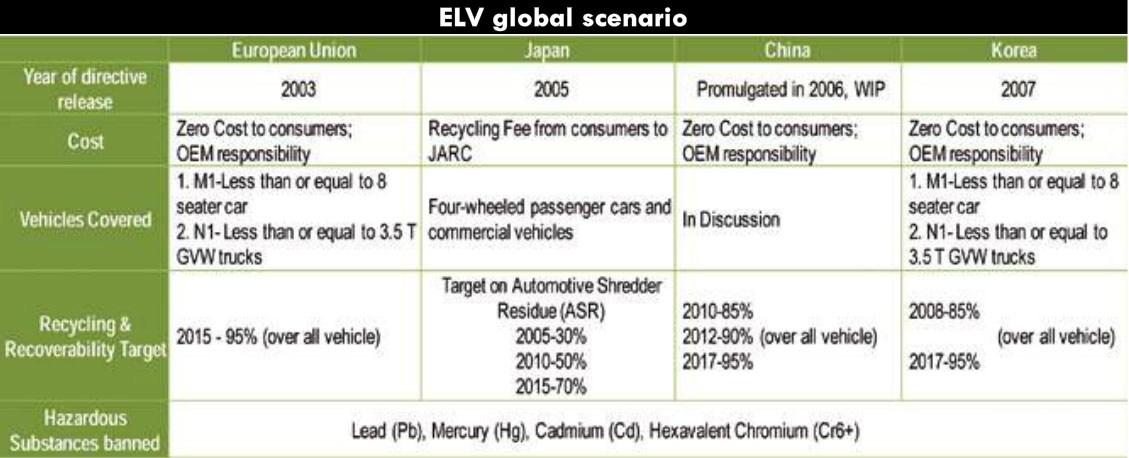Focus on pollution control, vehicle recyclability
By P. Parthasarathy, President ES, APA Engineering
 There is growing awareness of environmental issues, including pollution and recyclability of manufactured goods. One of the biggest polluters has been used cars disposed at junk yards. In order to tackle this issue, the European Union (EU) has taken an initiative to address these issues by enforcing an End-of-Life Vehicles (ELV) directive which focuses on reducing the hazardous substances and improving the recyclability of the car.
There is growing awareness of environmental issues, including pollution and recyclability of manufactured goods. One of the biggest polluters has been used cars disposed at junk yards. In order to tackle this issue, the European Union (EU) has taken an initiative to address these issues by enforcing an End-of-Life Vehicles (ELV) directive which focuses on reducing the hazardous substances and improving the recyclability of the car.
The ELV directive also requires OEM and other stake-holders to establish several collection centers to collect old cars and dismantle / recycle as per the directive listed standards / targets. The directive requires automotive manufacturers to prove that their car meets the recyclability target (95 per cent by 2015) and restrict the usage of hazardous chemicals such as Pb, Cd, Hg and Cr6+.
There is a strong need to have such kind of Indian ELV directive to manage the growing automobile population. A few automotive industry bodies have been reportedly working to frame a similar directive and get it approved by the Indian Government.
ELV directive 2000/53/EC was issued by the European Union in 2000 with an aim to reduce hazardous substances such as lead, cadmium, mercury and hexavalent chromium in M1 (cars with less than eight passengers, excluding the driver seat) and N1 (trucks less than 3.5 tonnage GVW) category vehicles. This directive has also enforced strict norms on recyclability targets such as 95 per cent recyclability / recoverability by 2015 for all the vehicles which are placed in the European market.
Japan, Korea and China have also enforced similar legislations, while many automotive OEMS in North America are voluntarily following the EU ELV directive which also requires setting up of recycling infrastructure and collection centers to collect the End of Life vehicles from the end consumers.
The maximum allowable percentage for lead, mercury and hexavalent chromium is 0.1 per cent and cadmium is 0.01 per cent by weight. In order to meet this regulation, OEMs require all their suppliers to provide detailed material breakdown analysis reports (Material Data Sheets) on the parts and assemblies they supply. OEMs such as Audi, BMW, Daimler, Ford, Opel, Porsche, VW and Volvo formed a consortium for automotive manufacturers to register Material Data Sheets of all their products in an online database called the International Material Data System (IMDS). The rest of the OEMs and suppliers gradually joined the group. Now it has more than 55 OEMs and all of their suppliers.
 In this IMDS database, every supplier and OEM has to register their company in order to report their IMDS sheets. Once registered, suppliers will be able to submit the IMDS data sheet to their customers with the complete part, material, basic substance details and recyclate information.
In this IMDS database, every supplier and OEM has to register their company in order to report their IMDS sheets. Once registered, suppliers will be able to submit the IMDS data sheet to their customers with the complete part, material, basic substance details and recyclate information.
Close to 90,000 suppliers are now registered in IMDS, with 170,000+ active users. Started with 7 OEM participation in IMDS in 2000, currently 55+ auto companies participate as OEMs in IMDS. Almost 99 per cent of OEMs and auto supply chain use the IMDS database as a tool to the meet ELV requirements.
The ELV directive has two major requirements – improving the recyclability of the vehicle parts and minimizing the use of hazardous substances such as Pb, Cd, Hg and Cr6+.
It requires all the materials used in the vehicle to categorize into seven material families as per ISO 22628 – metals, polymers, excluding elastomers, elastomers, glass, fluids, modified organic natural materials (MONM), and others (components, materials where a detailed breakdown cannot be established).
2015 type approval target – recyclability >85 per cent and recoverability >95 per cent.
APA Engineering, a Chennai-based engineering and sourcing company, has a very strong team to support the automotive OEMs and supply chain to meet the ELV directive requirements for the automotive industry, especially by giving end-to-end IMDS compliance support. Recently APA won two major orders from leading global auto MNCs.
The recent happenings in India towards ELV directive for vehicles are NATRiP establishing the Recycle Demo Center in Chennai and a few automotive industry bodies working towards framing the ELV directive. The purpose of the Demo Center is research in ELV recycle in India. Indian OEMs have provided old vehicles for the center.
Maruti has already taken an initiative to make its vehicles ELV-compliant and launched a few ELV-compliant cars already in the market.
There is every likelihood of a similar ELV being introduced in India soon.